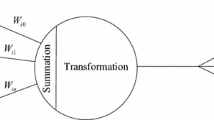Abstract
This paper explores the impact of the age structure on regional productivity. An estimation model based on artificial neural network (ANN) was developed on the assumption that demographic change, due to aging and migration has a significant effect on the regional productivity, especially in rural regions. A multilayer perceptron ANN model was applied to consider the composition of demographic structure rather than ratio between two population groups such as aged-child ratio. Regional productivity was estimated by applying the estimation model developed in this research study to population and aggregate product data of sixteen South Korean cities and counties, from 2000 to 2011. Developed model is trained with data of sixteen cities and counties, from 2000 to 2009, and verified with observation data and estimation results of 2010 and 2011. The results revealed that gross regional domestic product per capita, which represents regional productivity, is significantly related to demographic structure and can be estimated by age structure.















Similar content being viewed by others
References
An DH, Kwon OS, Lee SW (2003) The determinants of the performance of manufacturing industries in Korea: a frontier production function approach. J Korea Plan Assoc Korea Plan Assoc 38(6):149–172
Benitez JM, Castro JL, Requena I (1997) Are artificial neural networks black boxes? IEEE Trans Neural Netw 8(5):1156–1164
Bronzini R, Piselli P (2009) Determinants of long-run regional productivity with geographical spillovers: the role of R&D, human capital and public infrastructure. Reg Sci Urban Econ 39(2):187–199
Brunow S, Hirte G (2009) The age pattern of human capital and regional productivity: a spatial econometric study on german regions. Pap Reg Sci 88(4):799–823
Burtless G (2013) The impact of population aging and delayed retirement on workforce productivity. The center for retirement research at Boston College (working paper)
Byeon CU, Choi YK, Kim DS (2011) The spatial pattern analysis of economic activity: focusing on linkages between regional economic activity and migration. Korea Inst Ind Econ Trade 595:39–49
Chang FJ, Chiang YM, Cheng WG (2013) Self-organizing radial basis neural network for predicting typhoon-induced losses to rice. Paddy Water Environ 11(1–4):369–380
Conway RS (1990) The Washington Projection and Simulation Model: a regional interindustry econometric model. Int Reg Sci Rev 13(1):141–165
Dixon R, Thirlwall P (1975) A model of regional growth-rate differences on Kaldorian lines. Oxford Econ Pap 27(2):201–214
Feyrer J (2007) Demographics and productivity. Rev Econ Stat 89(1):100–109
Goldfarb RS, Yezer AMJ (1976) Evaluating alternative theories of intercity and interregional wage differentials. J Reg Sci 16(3):345–363
Hashimoto S, Sato Y (2008) Participatory rural planning in Japan: promises and limits of neighborhood associations. Paddy Water Environ 6(2):199–210
Imam P (2013) Demographic shift and the financial sector stability: the case of Japan. J Popul Ageing 6(4):269–303
Jahanbani H, El-Shafie AH (2011) Application of artificial neural network in estimating monthly time series reference evapotranspiration with minimum and maximum temperatures. Paddy Water Environ 9(2):207–220
Kang MS, Park SW (2003) Short-term flood forecasting using artificial neural networks. J Korean Soc Agric Eng 45(2):45–57
Kang MS, Kang MG, Park SW, Lee JJ, Yoo KH (2006) Application of grey model and artificial neural networks to flood forecasting. J Am Water Resour Assoc 42(2):473–486
Kim YS (2002) A study on the productivity and the determinants of its regional industry and the determinants: centering on the regional knowledge-based manufacture. Korea Institute for Industrial Economics & Trade, Seoul, pp 22–41
Kim YS, Byeon CU, Lee SH (2009) Productivity and policy effects of regional industry in Korea. Korea Inst Ind Econ Trade 558:69–82
Kuo SF, Chen FW, Liao PY, Liu CW (2011) A comparative study on the estimation of evapotranspiration using backpropagation neural network: Penman–Monteith method versus pan evaporation method. Paddy Water Environ 9(4):413–424
Lee CK, Choi MS, Kim EJ (2009) The analysis of determinants of total factor productivity: employing DEA and 2SLS. J KRSA 25(3):25–43
Lugauer S, Redmond M (2012) The age distribution and business cycle volatility: international evidence. Econ Lett 117(3):694–696
Mjalli FS, Al-Asheh S, Alfadala HE (2007) Use of artificial neural network black-box modeling for the prediction of wastewater treatment plants performance. J Environ Manag 83(3):329–338
Motosugi A (2003) The farmland and rural improvement project budget under the agriculture basic law in Japan. Paddy Water Environ 1(2):59–63
Poot J (2008) Demographic change and regional competitiveness: the effects of immigration and ageing. Int J Foresight Innov Policy 4(1–2):129–145
Sánchez-Romero M (2012) The role of demography on per capita output growth and saving rates. J Popul Econ 26:1347–1377
Skirbekk V (2005) Population ageing negatively affects productivity. Vienna yearbook of population research, Vienna, pp 5–6
Siliverstovs B, Kholodilin KA, Thiessen U (2010) Does aging influence structural change? Evidence from panel data. Econ Syst 35(2):244–260
Williams M, Moomaw RL (1989) Capital and labour efficiencies: a regional analysis. Urban Stud 26:573–585
Yamaoka K, Tomosho T, Mizoguchi M, Sugiura M (2008) Social capital accumulation through public policy systems implementing paddy irrigation and rural development projects. Paddy Water Environ 6(1):115–128
Yeo JH, Holland D (2004) Economic growth in Washington: an examination of migration response and a test of model accuracy. Int Reg Sci Rev 27(2):205–237
Yoon BD (2012) Gyeonggi economic outlook. Gyeonggi Res Inst 157(1):1–22
Acknowledgements
This research is supported by Bio-industry Technology Development Program (no.311009-3), Korea Institute of Planning and Evaluation for Technology in Food, Agriculture, Forestry and Fisheries.
Author information
Authors and Affiliations
Corresponding author
Rights and permissions
About this article
Cite this article
Lee, J., Kang, M.S., Lee, J.J. et al. Estimating regional productivity based on demographic structure with artificial neural network. Paddy Water Environ 13, 353–365 (2015). https://doi.org/10.1007/s10333-014-0451-1
Received:
Revised:
Accepted:
Published:
Issue Date:
DOI: https://doi.org/10.1007/s10333-014-0451-1




